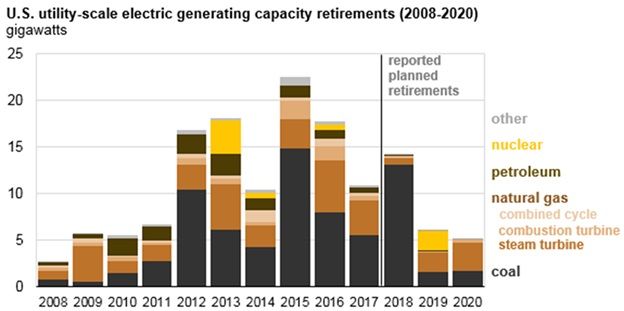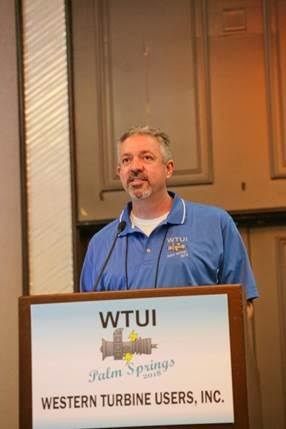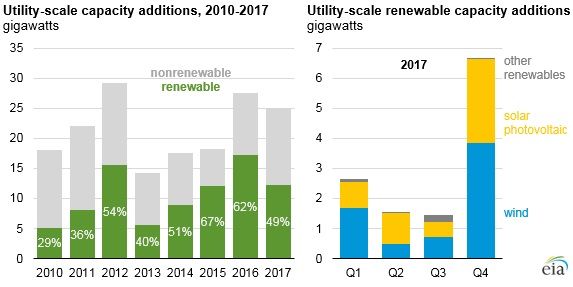Tough times for turbines
The Western Turbine Users Inc. (WTUI) conference is the largest aeroderivative gas turbine (GT) user group gathering in the world. About 1,100 people attended the March 2018 event in Palm Springs, California to hear about rapid change in the industry.
Chuck Casey, President of WTUI and the operator of a City of Riverside gas turbine plant in California, operates nine peakers – 4 are GE LM6000s. His plant has a combined cycle unit, and even that also operates as a peaker due to shifts in the generation mix. His units only run at about 3% capacity.
“My LM turbines are being challenged to start faster and more often, operate with lower emissions, have a lower power turndown and higher output, while staying reliable and being available,” said Casey.
This marks a huge change from only a few years ago. Casey pointed to trends such as the Federal Clean Power Plan (CPP) mandating historic levels of renewable energy on the grid, causing coal and nuclear plants to be decommissioned simultaneously. Natural gas generation is also suffering in states such as California as wind and solar power are given priority. Increased subsidies for energy storage will put additional pressure on natural gas generation.

But all was not gloomy. Natural gas prices are maintaining a low range, amplifying the feasibility of GTs.
“There is no doubt that social influence through government, social media and environmentalists is affecting us,” said Casey. “To stay relevant, you must fit your aeroderivative engines to be limber and flexible.”

Distributed energy resources (DER) are another factor. Customers are no longer happy just to have power. They are beginning to demand that their energy come from certain places. This is causing power producers to think and act differently.
Casey gave the example of a joint Southern California Edison, GE and Wellhead project to create a battery-gas turbine hybrid system in Norwalk, California. The LM6000 Hybrid Electric Gas Turbine (Hybrid EGT) offers quick start, and fast ramping capabilities to support SCE’s growing renewable portfolio. A 10 MW battery energy storage system works in conjunction with a 50 MW LM6000 aeroderivative gas turbine.
California has committed to derive 50 percent of its electricity from renewable sources by 2030. The Hybrid EGT helps balance variable energy supply and demand, including during evening hours. The control system blends output between the battery and the gas turbine. It allows enough time for the GT to start and reach its designated output i.e. there is no need to burn fuel while keeping the turbine on standby. Demineralized water consumption is reduced by 45% at the plant. Casey said the LM6000 in this hybrid example is basically providing a new form of spinning reserve.

Source Energy Information Administration[/caption]
Statistics from the Energy Information Administration (EIA) were also cited. Out of 25 GW of utility-scale electric generating capacity added to the grid during 2017, nearly half use renewable technologies. Another 3.5 GW of small-scale solar net capacity additions came online in 2017. More than half of the renewables came online during the fourth quarter. Renewable capacity additions are often highest in the final months of the year to qualify for federal, state, or local tax incentives.
In early spring, California’s total solar share of gross electricity demand exceeded 50% during the mid-day hours. This resulted in negative pricing i.e. the state paid its neighbors to take the power off its hands. Looking at the U.S. as a whole, monthly electricity generation from wind and solar exceeded 10% of total U.S. electricity generation for the first time.
Casey acknowledged the problem, but believes the industry can adjust, and that it can find its place in the future energy mix. He noted that coal generation is down from 50% of U.S. electric generation to less than 30% over the past 12 years. During that same period, natural gas has risen from 20% to 33%. “For the third consecutive summer natural gas beat coal as an electricity generating source,” he said.
You can read the complete report on the 2018 WTUI show in the May/June print edition of Turbomachinery International.
Fuel Flexibility in Heavy-Duty Gas Turbines: A Key Driver for Energy Transition
March 13th 2025From Hydrogen to HVO, Mr. Federico Bonzani, Chief Technology Officer of Ansaldo Energia, describes the fuel flexibility state-of-the-art solutions of the Company to meet the actual and future needs of power generation industry.